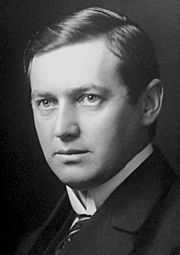Manne Siegbahn facts for kids
Quick facts for kids
Manne Siegbahn
|
|
|---|---|

Karl Manne Siegbahn in 1924
|
|
| Born |
Karl Manne Georg Siegbahn
3 December 1886 Örebro, Sweden
|
| Died | 26 September 1978 (aged 91) Stockholm, Sweden
|
| Alma mater | University of Lund |
| Known for | X-ray spectroscopy Siegbahn notation Siegbahn pump |
| Spouse(s) | Karin Högbom |
| Children |
|
| Awards |
|
| Scientific career | |
| Fields | Physics |
| Institutions | University of Lund University of Uppsala University of Stockholm |
| Notes | |
|
He is the father of Nobel laureate Kai Siegbahn.
|
|
Karl Manne Georg Siegbahn (born December 3, 1886 – died September 26, 1978) was a Swedish physicist. He won the Nobel Prize in Physics in 1924. He received this award for his important discoveries and research in the field of X-ray spectroscopy.
Contents
Manne Siegbahn's Life
Manne Siegbahn was born in Örebro, Sweden. His parents were Georg Siegbahn and Emma Zetterberg.
Early Education and Career
He finished school in Stockholm in 1906. That same year, he started studying at Lund University. While he was a student, he worked as an assistant for Johannes Rydberg, another famous physicist. In 1908, Siegbahn also studied at the University of Göttingen.
He earned his PhD from Lund University in 1911. His special project was about measuring magnetic fields. When Professor Rydberg became ill, Siegbahn took over his teaching duties. He became a full professor in 1920. In 1922, he moved to Uppsala University to become a professor there.
Leading a Physics Institute
In 1937, Siegbahn was chosen to be the Director of the Physics Department. This department was part of the Nobel Institute of the Royal Swedish Academy of Sciences. Years later, in 1988, this institute was renamed the Manne Siegbahn Institute (MSI) in his honor. Even though the research groups have changed, his name is still used today. The Manne Siegbahn Laboratory is now hosted by Stockholm University.
Discoveries in X-ray Spectroscopy
Manne Siegbahn started studying X-ray spectroscopy in 1914. This is a way to learn about atoms by looking at the X-rays they give off.
Improving X-ray Measurement
At first, he used a similar tool to the one Henry Moseley used. Moseley had found a link between the X-ray light from different elements and their place on the periodic table. Siegbahn then made much better tools. These tools allowed him to measure the X-ray light from atoms very, very accurately.
He also found that some of the X-ray lines Moseley had seen were actually made of many smaller parts. By studying these parts and making his tools even better, Siegbahn learned a lot about the electron shells inside atoms.
Siegbahn Notation
Siegbahn created a special way to name the different X-ray lines. This system is called the Siegbahn notation. His very precise measurements helped scientists understand more about quantum theory and atomic physics. These are important areas of physics that explain how tiny particles work.
Awards and Special Recognition
Manne Siegbahn received many awards for his work.
He won the Nobel Prize in Physics in 1924. He also won the Hughes Medal in 1934 and the Rumford Medal in 1940. In 1944, he invented and patented a special pump called the Siegbahn pump. In 1954, he was chosen as a Foreign Member of the Royal Society. This is a very high honor for scientists from other countries.
Family Life
Manne Siegbahn married Karin Högbom in 1914. They had two sons. Their son, Bo Siegbahn (1915–2008), became a diplomat and politician. Their other son, Kai Siegbahn (1918–2007), also became a physicist. Kai Siegbahn followed in his father's footsteps and won the Nobel Prize in Physics in 1981. He won it for his work on X-ray photoelectron spectroscopy, which is another way to study atoms using X-rays.
See also
 In Spanish: Manne Siegbahn para niños
In Spanish: Manne Siegbahn para niños

